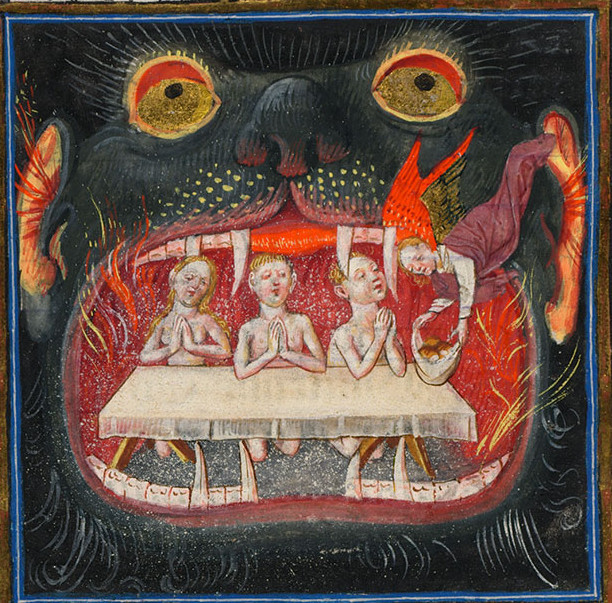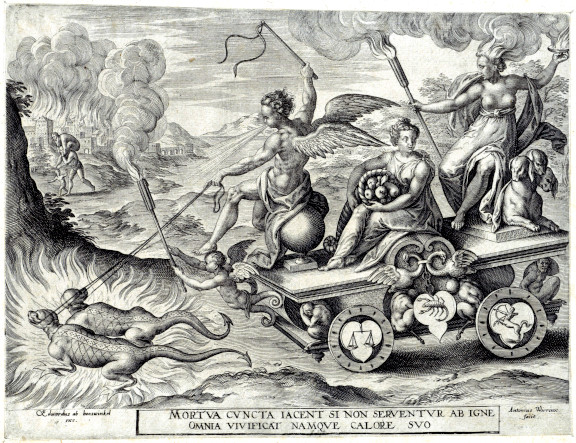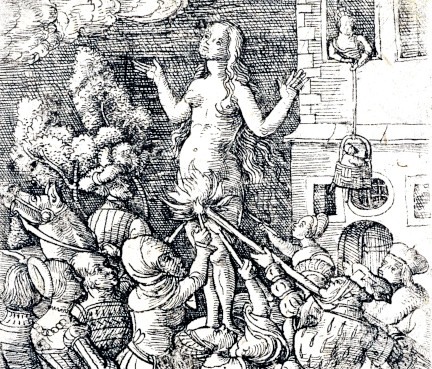An unexpected detour on the way to getting my book ready for publication took me deep into the fascinating, fun, but time-consuming world of image research.
The draft book proposal completed months ago promised that I would supply a list of possible illustrations on request, drawn from our rich heritage of beautiful, amusing, and intriguing depictions of fire. My book coach however suggested that I proactively research and select these illustrations, secure in advance the rights to use them, and make sure I have access to high-resolution digital files suitable for printing. The process, he predicted, would take much longer than I expected.
As usual, his advice was spot on. Though most of my selections are in the public domain, securing the right to use them requires careful research and can incur significant expense. Much depends on the policies of the institution that owns the original work.
Many great museums and libraries, fortunately, have chosen an “open access” policy, which allows you to freely copy, modify, and distribute images, even for commercial purposes. These include the Metropolitan Museum, the Wellcome Collection, Yale University Libraries, and the Getty Museum (but not Getty Image$, which charges the max.) The Rijksmuseum in Amsterdam, which has a wonderfully deep collection of old Dutch engravings in particular, even encourages you to create a “Rijksstudio” and fashion their images into something of your own. When you download a digital file, a dialog pops up prompting you: “What will you create? The image you just downloaded is supersharp. Sharp enough to turn a single detail into a shirt. Or a car. Or a phone case. Start creating your own masterpiece! View tips and examples…”
All things lie dead if not preserved by fire, for it vivifies all things by its heat. In an image packed with symbols, a female personification of fire, her head engulfed in flames, rides a chariot pulled by flaming salamanders. She sits on the three-headed dog Cerberus, guardian of the gates of Hades, while a personification of fertility rides as passenger. In the background, reminding us of the destructive side of fire, Aenaes saves his aged father from the burning city of Troy. Anton Wierix II (before 1604). Rijksmuseum, Amsterdam
Other institutions keep tight control over the works in their collections, whether “public domain” or no. The Morgan Library “allows reproduction only from publication quality digital image files;” you need to pay them to create new artwork even if files of good quality can be found on their own website or elsewhere. This includes images from the Book of Hours of Catherine of Cleves. I would have liked to use a miniature from that work, “Souls in Purgatory Consoled with the Offering.” It depicts an angel delivering sacramental bread, made possible by the donations of people still living, to souls kneeling at a communion table in the flaming mouth of Hell. It beautifully illustrates much of what I say about Purgatory.

Images from Catherine of Cleves do appear in Wikimedia Commons. According to the official position of the Wikimedia Foundation, I have the right to use them: “faithful reproductions of two-dimensional public domain works of art are public domain.” A publisher however will very likely require that I get permission from the Morgan, which not only requires that I pay for photo reproduction but will charge a fee based on who the publisher will be for my book, how many copies will be printed, how many “specific languages” it will be printed in, what media, how many editions etc. This permission will be good for three years, after which I must apply again. I filled out their form hoping to get a ballpark idea of the cost, noting that I don’t yet have answers to these questions. They responded with an invoice for a $60 reproduction fee “for research only” and another form to fill out when I have answers to all these specifics. They will then determine the fee. Fortunately, there are plenty of other great images I can use to illustrate my chapter on the fires of Purgatory.

The Bibliothèque nationale de France, thankfully, has a much simpler policy: they charge a one-time Tarif of 60€ for use of an image on an interior page of a book. I like this clearly defined cost, since I would very much like to use a unique image from a fourteenth-century illuminated manuscript in their collection.
It depicts priests blessing a pilgrim entering a famous cave in Ireland known as St. Patrick’s Purgatory. For centuries, believers came from all over Christendom to spend a night in this cave, where they would be seized by demons and endure fiery tortures until morning—if they managed to survive at all. Why would anyone choose to spend a night in a cave, risking death at the hands of fire-wielding demons? Because such a visit works like a vaccination for the soul: if you survive, you will be spared much worse tortures in the afterlife.
Other institutions, such as the British Museum, allow free use of their works in the public domain except for “commercial use,” which includes books like mine. I sent an inquiry to their sales department about a 16th-century German etching sometimes called The Revenge of the Sorcerer Virgil. It illustrates a popular bawdy medieval story about how the Roman poet Virgil fell in love with the beautiful daughter of the Emperor. She embarrassed him, leaving him dangling in a basket while trying to get up to her chambers (depicted in the background).
The amorous poet, also a sorcerer, magically extinguished all fires in Rome. The Roman citizenry could only light them again when Princess Febilla stood naked in the Forum while they rekindled their torches from the fiery focus of her erotic allure.
Of the several copies of this print I found in museums around the world, the British Museum had the only one downloadable in suitable resolution that I could find. How much would it cost to license it? They too require the name of the publisher, the unit run (both printed copies and e-book downloads), language(s), territorial distribution, reproduction size (1/4, 1/2, or full page), and expected audience of the publication. Oh, and they don’t consider the file on their site to be of “commercial quality,” so I should also pay £60 for new photography.
Annoyed, I dug a little further and found an even better copy at the Biblioteka Narodowa in Poland. With the help of Google Translate I determined that “It is allowed to reproduce, change and distribute and perform the work, even for commercial purposes, without having to ask for permission.”
Aside from the occasional frustration with such bureaucratic obstacles, I had great fun curating my collection of digital images. In addition to the selection that I will propose to publishers for inclusion in the book, I came across many more beautiful, evocative, and downright weird images. Some of these I will post to Instagram and elsewhere in this blog.

Share via:



Thanks for this, Jim! I have procrastinated learning how to search for and create visual images online — something I need to do for my own creative work. This entry of yours gives me courage, zest, and some specifics to follow up on. Much appreciated.
Thanks, Karen. Good luck with your search, and securing the rights stuff.